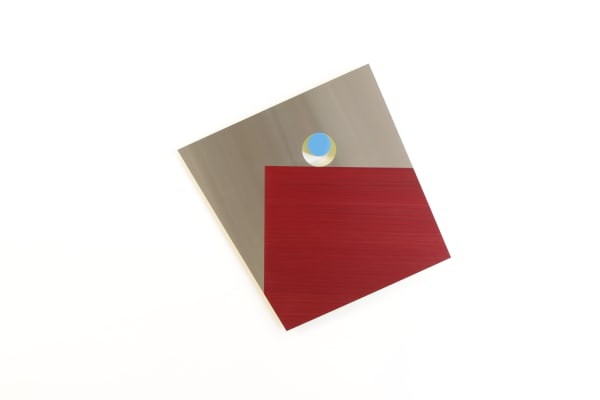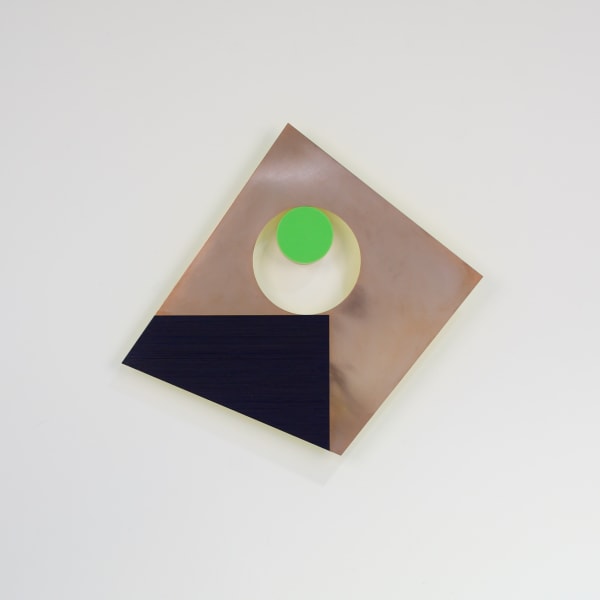-
-
 PLINTH No.10 - Yellow Pink Blue, 2022
PLINTH No.10 - Yellow Pink Blue, 2022 -
 PLINTH No.11 - Red Green White, 2022
PLINTH No.11 - Red Green White, 2022 -
 PLINTH No.12 - Black Yellow Blue, 2022
PLINTH No.12 - Black Yellow Blue, 2022 -
 PLINTH No.13 - Light Blue Red Prussian Blue, 2022
PLINTH No.13 - Light Blue Red Prussian Blue, 2022
-
 PLINTH No.14 - Blue Yellow Crimson, 2022
PLINTH No.14 - Blue Yellow Crimson, 2022 -
 PLINTH No.7 - Light Blue, 2021
PLINTH No.7 - Light Blue, 2021 -
 PLINTH No.6 - PHTHALOCYANINE BLUE, 2021
PLINTH No.6 - PHTHALOCYANINE BLUE, 2021 -
 PLINTH No.5 - TITANIUM WHITE, 2021
PLINTH No.5 - TITANIUM WHITE, 2021
-
-
The Plinth series evolved during the post pandemic period when I was playing with materials and revisiting old ideas in the studio. For years I had a rectangular piece of plywood hanging on a nail on the wall that had had a circular section cut out of it for a previous artwork. It always hung at an angle, due to the weight of the remaining wood, continuingly begging me to exploit this imbalance in a series of artworks.
Perhaps one of the most crucial influences were Anthony Caro’s table sculptures. Caro’s early welded steel sculptures were famous for jettisoning sculpture’s traditional base but his table pieces consciously played with ideas of placement and balance sometimes appearing to hang over the side of a table and in so doing allowing the sculpture to emerge into new kinds of personal space beyond the plinth. This sense of teetering on the edge of a table is a crucial element in my Plinth works.
The literal reading of the idea is one of the hole or negative space representing an abstract sculpture that is perched precariously near or on the edge of a table personified by an area of thick linear oil paint on sheet metal. There is an implied sense that this element of tangible space could fall off the ‘plinth’ on which it sits adding a subtle tension to the fine balance of line and form at the same time that it forms the basis for how the artworks is attached to the wall.
The works are made of irregular quadrilaterals of thin sheet metal with a perfect circular hole cut out of it: the angles are not specific, and the hole is not specifically placed. The process, like many of my more recent projects, allows an element of chance to become a deciding factor in the end result of each artwork. Here, once the metal form is suspended from a smaller fixed cylinder on the wall, gravity works its invisible magic, and the irregular form naturally finds its own equilibrium with the larger, weightier section being closest to the floor with only the feintest touch between the two components. At this point in the process there is no paint on the metal sheet as this can only be added after the balance has been found, and an area that represents the plinth delineated. If you add anything to one side of a balance it will tip toward the heavier side. This is also true of these artworks. If I add paint to one side of the sheet the balance will shift, and the marked horizontal and vertical edges will not be true. The process requires that the paint is then weighed, allowing the balance to be altered for the addition of the weight of paint. It’s all a bit scientific but it is imperative the horizontal and verticals within the picture are perfect and true. The white block plinths, synonymous in museums and galleries the world over, are never not square to the ground, so here my challenge is to emulate this prerequisite in a wall-based artwork that is continually open to the performative effects of gravity.
Humans naturally feel comfortable with true verticals and true horizontals. Since we walked upright on two legs the vertical has been intrinsic to our sense of the world, a world also dominated by the wide horizon line between the earth and the sky. Architecture, and in its way modernism, have enhanced our encoded sense of a vertical and horizontal world. I want to tap into this karma by confronting the viewer with an uneasy diagonal quadrilateral that should exude a sense of imbalance but feels somehow grounded as we connect with the vertical and horizontal edges visible within the artwork. I am also interested and amused by the idea of straightening an artwork on a wall. How many of us have nudged the corner of a frame to make it look straight; imagine a Jackson Pollock’s work of chaotic brilliance that was not hung straight on the wall!
For over a decade I have been exploring the notion of sculpture in ways as thin and flat as possible. Blurring of both two and three-dimensional fundamentals has been front and centre of my practice and so it is with the Plinth series. The works occupy a painterly sense of space as they inhabit a flat area on a wall but at the same time allow for an examination of materials and space more commonly associated with sculpture. Fontana’s cut canvases continue to influence me but here the penetrated surface is not a singular action, more a means by which the picture can be hung on the wall, and in a sense, a portal through which on can discover to some of the secrets of the artwork. Form and function combine to create a picture plane that barely touches its support, both fills the space on the wall and virtually disappears from the side, revealing itself as merely a thin sheet of metal suspended in a coloured space of its own creation.
At its heart the Plinth project is a simple exploration of the elements that constitute a traditional ‘painting’ on the wall while teetering towards sculpture. Logic and reason abound where sculpture and painting vie for supremacy. Spend time and most of your questions will be answered as it is not complicated but it can be complex.
-
PLINTH No.6 - PHTHALOCYANINE BLUE
Copper, Wood, Oil & Acrylic Paint
55 x 40 cm
















